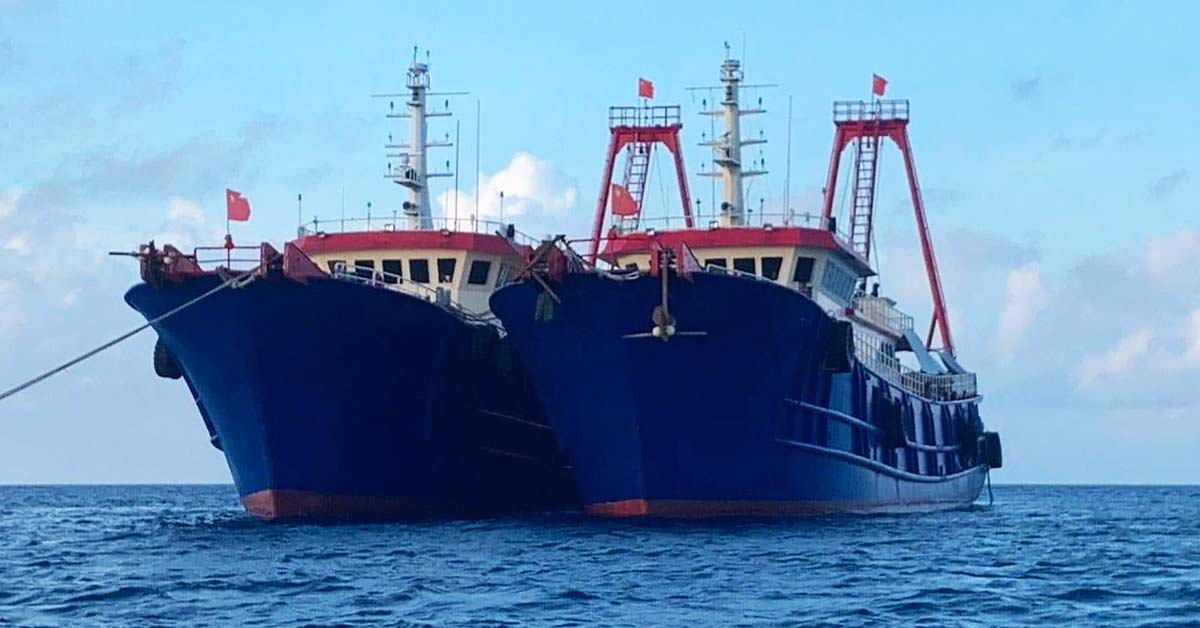They've been dubbed China's "Little Blue Men," an allegedly Beijing-controlled maritime militia that analysts say could be hundreds of boats and thousands of crew members strong.
China doesn't acknowledge their existence and when questioned, refers to them as a "so-called maritime militia."
But Western experts say the alleged militia is an integral part of Beijing's efforts to exert its territorial claims in the South China Sea and beyond. They claim its blue-painted vessels and their crews – allegedly funded and controlled by the People's Liberation Army – can quickly bring a Chinese presence so large around disputed reefs and islands that they are almost impossible to challenge without triggering a military confrontation.
The apparent militia made headlines last month when more than 200 Chinese fishing boats crowded around Whitsun Reef, a Philippine possession in the Spratly Island chain in the South China Sea.
The Philippines protested the Whitsun incident to Beijing, calling the boats a "swarming and threatening presence" and saying the flotilla was infringing on Philippine territory and fishing grounds. Manila demanded the Chinese boats leave the area, which it maintains is in its exclusive economic zone (EEZ).
Beijing countered that the boats, which numbered 220 at one point, were simply escaping rough seas by moving within a lagoon formed by the boomerang-shaped Whitsun Reef, which Beijing calls Niu'e Jiao and claims as part of its territory.
The diplomatic back and forth between Philippine and Chinese officials continued last week, with the Chinese Embassy in Manila calling remarks by the Philippine defense secretary regarding the Chinese boats as "wanton" and "perplexing."
The Philippine Department of Foreign Affairs fired back, deploring the Chinese Embassy's statement, reminding China its diplomats are "guests" in Manila and pledging to issue daily diplomatic protests while Chinese vessels are in the Philippines' maritime zone.
How Does The Chinese Maritime Militia Allegedly Work?
Despite Chinese government denials, there is little ambiguity in Western circles about what the Pentagon calls the People's Armed Forces Maritime Militia (PAFMM).
"The People's Armed Forces Maritime Militia don't fish," Carl Schuster, a former director of operations at the United States (US) Pacific Command's Joint Intelligence Center said. "They have automatic weapons aboard and reinforced hulls, making them very dangerous at close range. Also, they have a top speed of around 18-22 knots, making them faster than 90 percent of the world's fishing boats."
"The Maritime Militia is used by Beijing 'to subvert other nations' sovereignty and enforce unlawful claims," a December report from the heads of the US Navy, Marines and Coast Guard said.
"The Militia is a key component of China's Armed Forces and a part of what it calls the 'People's Armed Forces System,'" Conor Kennedy and Andrew Erickson, two leading American experts on the subject, wrote for the US Naval War College in 2017.
It is "a state-organised, -developed, and -controlled force operating under a direct military chain of command to conduct Chinese state-sponsored activities," they added.
The alleged militia is integrated with China's fishing fleet, the world's largest with more than 187,000 boats, Erickson told CNN, but the actual number of armed boats remains unclear to Western experts.
Whatever their ranks, experts say they can lead large flotillas of actual fishing boats in actions to further Chinese government policies and territorial claims – including those in the South China Sea.
"China is typically secretive about its Third Sea Force (behind the PLA Navy and coast guard), which might conceivably number in the thousands of vessels and in the tens of thousands of personnel. Possibly more," Erickson said.
A 2020 US Defense Department report on the Chinese military mentions only 84 actual maritime militia boats, all assigned to a unit operating out of Sansha City on Hainan island, in the northern reaches of the South China Sea. The unit, established in 2016, gets frequent subsidies to operate in the Spratly Islands, the report said.
"This particular PAFMM unit is also China's most professional. Its forces are paid salaries independent of any clear commercial fishing responsibilities and recruited from recently separated veterans," it said.
But Erickson noted that the boats seen around Whitsun Reef in recent weeks looked different from those in the Hainan unit, suggesting full-time militia boats are greater in number than previously thought.
As of 29 March, only 44 boats remained in the Whitsun Reef lagoon. The rest had scattered to other contested reefs and islands in nearby waters.
What Is The Purpose Of A Maritime Militia?
The concept of a maritime militia, or an irregular naval force, allows China to make territorial claims in huge numbers without ever involving the PLA proper, Western experts say.
Even if lead boats like those mentioned by Erickson and Martinson are relatively small in number, they can spearhead flotillas in the hundreds – as seen in Whitsun Reef.
Jay Batongbacal, director of the Institute for Maritime Affairs at the University of the Philippines, summed up what Beijing has done in recent weeks at Whitsun Reef and recent years across the South China Sea – 1.3 million square miles of water, almost all of which Beijing claims as Chinese territory.
"They are now essentially occupying Whitsun Reef by the mere presence of their vessels," Batongbacal said in an interview with National Public Radio.
"That's actually the objective of the Chinese strategy, to establish de facto control and dominance over the entire South China Sea through these incremental moves." – CNN
Related Articles:
